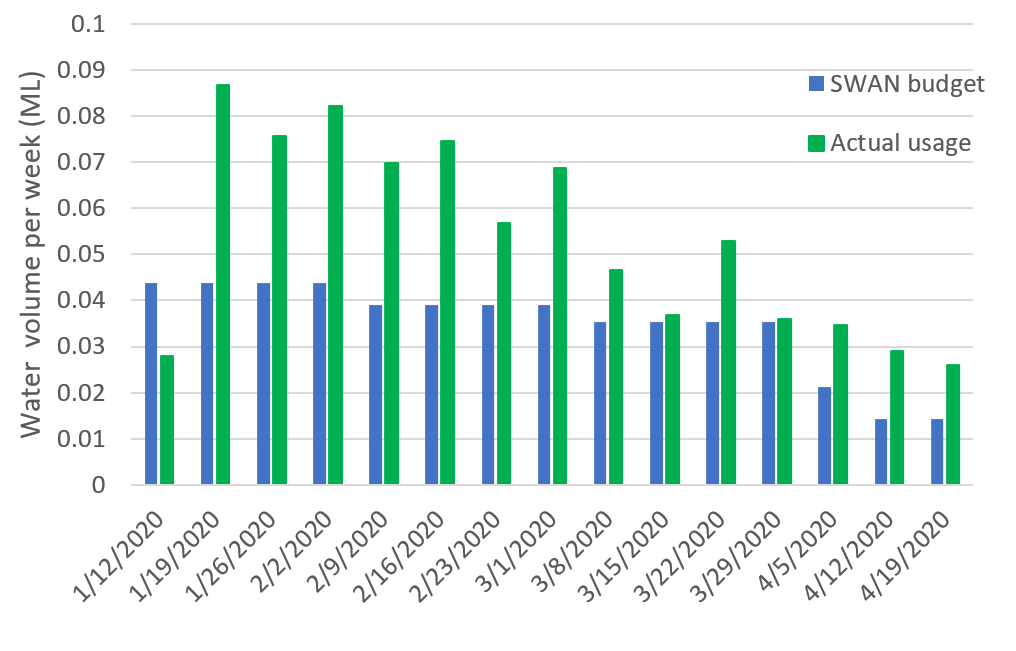As cities and suburbs become increasingly built-up, having enough urban green space to supplement them is more important than ever.
Urban green spaces are public and private open areas reserved for parks and other ‘green spaces’, usually including some form of plant life, water features, or other natural vegetation.
However, green space requires water to keep it that way – a resource that is becoming increasingly scarce due to population growth and a changing climate. With 10 to 20 million extra people projected to be living in Australian cities in the next 50 years[1], this is no small-scale problem. Smart irrigation that makes the most out of every drop of water is key to maintaining our all-important urban green spaces; whilst conserving water.

The Importance of Urban Green Space
So why are urban green spaces so important to local communities? As well as direct improvements to air quality and local biodiversity, there are indirect health benefits to having adequate public green space. Chronic stress and insufficient physical activity are growing societal trends; often made worse by modern urban life (or indeed, a pandemic). The availability of parks, playgrounds and residential greenery can promote physical and mental health, providing a recreational space to exercise, socialise, and alleviate stress.
Not only this, but urban green spaces have been proven to lower the ambient air and land surface temperature of nearby environments, reducing the incidence of the ‘urban heat island effect’. Research has shown that a 1-2 °C increase in global temperature could increase the number of heat-related deaths among the elderly in our capital cities by up to 123%[2].
The vegetation itself also contributes to carbon sequestration, helping to capture and store harmful carbon dioxide emissions. Finally, urban green spaces provide local communities with a ‘sense of place’, whilst helping to increase the economic value of nearby real estate.

Challenges with Urban Green Space
Given how many proven benefits urban green space provides, why are we at risk of losing some of it?
Rising populations and associated growth pressures mean that urban space is in greater demand, as are the natural resources required to sustain human life. In this case, water is the main resource necessary to keep urban green spaces, well, green. However, a changing climate – particularly the drought conditions being experienced throughout Australia – mean that water conservation is a critical consideration for governments and town planners.
Basic economics tells us that when demand outweighs supply, prices will increase. This is true of water; and will likely continue to rise over time. As well as the high costs of irrigating urban green space, water managers (such as local councils) often experience complications overseeing multiple locations. The prevalence of ‘remote operations’ has been expedited in the current pandemic, meaning that water managers can’t be on site to manage irrigation.
Finally, rising public scrutiny and compliance requirements are forcing water managers to be more accountable for their water use. There’s nothing quite as frustrating as driving past your local park before/during/just after rain, and the sprinklers are on… An incident that residents are becoming less forgiving of. Surely, in this day and age, there is a better solution to basic sprinkler timers and schedules that pay little (or no) attention to the local conditions? Thankfully, the answer is yes… Read on!

Water Management Solutions in Urban Green Space
As with many complex societal issues, there is no ‘silver bullet’ that will solve these challenges in one-fell-swoop. There is, however, the opportunity to leverage the data and technologies at our disposal to drive water use efficiencies, reduce costs, and improve management practices; which in turn will allow us to have our cake and eat it too (i.e. – maintain/increase urban green space whilst conserving water).
Smart urban irrigation involves applying the right amounts of water and nutrients to satisfy plant growth, at the right time. It involves using historic, current, and predictive data that is tailored to the exact geography and irrigation context. It leverages data from multiple sources, such as soil moisture probes, satellite imagery, forecast weather, and more.
Sounds complex, right?! Well, it doesn’t have to be. SWAN Systems is a software solution that transforms data from these inputs into actionable irrigation insights, allowing water managers to use only what’s needed; whilst saving them time and management heartache. SWAN uses a mixture of industry-best-practice crop models and tailored models based on specific plants, variety, soil type, climate, season and more to determine how much water and nutrients are required.
Not only does this help to conserve water, but it makes life easier for those managing the irrigation of urban green spaces. The reporting component of SWAN is designed to provide a bird’s eye view of what’s going on from a water and nutrient management perspective, across the whole or multiple operations. As well as this, irrigation schedules can be automatically produced based on the configured irrigation system, which can then be sent to, or programmed into, irrigation control systems.

As you can see from the graph taken from an SA Water Case Study which show the actual water usage compared with the ‘required’ budget calculated by SWAN, smart irrigation software can allow significant water savings (up to 30%) to be achieved – with no loss of ‘greenness’. Water managers will no longer be relying on assumptions, and residents will no longer be pulling out their hair when the sprinklers come on when it has been raining!
As well as water management, SWAN has a Nutrient module that assists irrigation managers in the safe and efficient use of recycled or treated water for irrigation. It is likely that recycled water will form a key component of sustainable, liveable cities in the future. However, use of reclaimed water requires careful management to avoid the hazards created by excessive nutrient use and increased run-off and leaching due to over-irrigation.
Therefore, technology solutions such as SWAN, combined with strategic approaches to urban green space design and development (i.e. location and plant/grass species), will be key to helping us to conserve water – whilst enjoying urban green spaces.
Want to learn more about how data can be used to save water and make better irrigation decisions? Check out our case study on a sporting complex within the City of Armadale.
[1] https://www.publish.csiro.au/ebook/chapter/9780643103283_Chapter_6#:~:text=Half%20of%20the%20world’s%20population,by%202050%20(Figure%206.1).&text=Australia%20is%20already%20highly%20urbanised,will%20live%20in%20Australian%20cities.
[2] https://www.smh.com.au/interactive/2016/sydney2026/chapter5.html






